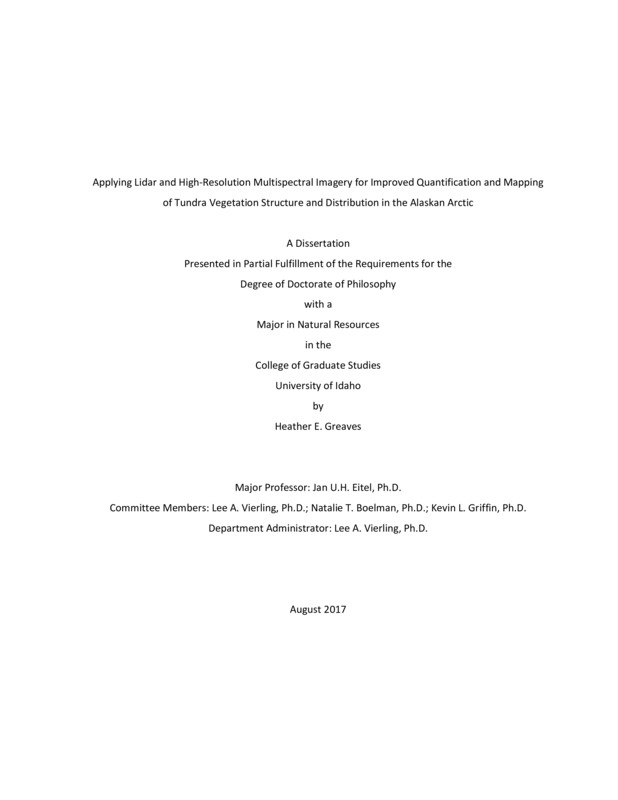Applying Lidar and High-Resolution Multispectral Imagery for Improved Quantification and Mapping of Tundra Vegetation Structure and Distribution in the Alaskan Arctic
Greaves, Heather E.. (2017-08). Applying Lidar and High-Resolution Multispectral Imagery for Improved Quantification and Mapping of Tundra Vegetation Structure and Distribution in the Alaskan Arctic. Theses and Dissertations Collection, University of Idaho Library Digital Collections. https://www.lib.uidaho.edu/digital/etd/items/greaves_idaho_0089e_11201.html
- Title:
- Applying Lidar and High-Resolution Multispectral Imagery for Improved Quantification and Mapping of Tundra Vegetation Structure and Distribution in the Alaskan Arctic
- Author:
- Greaves, Heather E.
- ORCID:
- 0000-0002-8800-019X
- Date:
- 2017-08
- Keywords:
- Applied predictive modeling Imnavait Creek Landscape ecology Random Forest Toolik Lake
- Program:
- Natural Resources
- Subject Category:
- Remote sensing; Ecology; Plant sciences
- Abstract:
-
Climate change is disproportionately affecting high northern latitudes, and the extreme temperatures, remoteness, and sheer size of the Arctic tundra biome have always posed challenges that make application of remote sensing technology especially appropriate. Advances in high-resolution remote sensing continually improve our ability to measure characteristics of tundra vegetation communities, which have been difficult to characterize previously due to their low stature and their distribution in complex, heterogeneous patches across large landscapes.
In this work, I apply terrestrial lidar, airborne lidar, and high-resolution airborne multispectral imagery to estimate tundra vegetation characteristics for a research area near Toolik Lake, Alaska. Initially, I explored methods for estimating shrub biomass from terrestrial lidar point clouds, finding that a canopy-volume based algorithm performed best. Although shrub biomass estimates derived from airborne lidar data were less accurate than those from terrestrial lidar data, algorithm parameters used to derive biomass estimates were similar for both datasets. Additionally, I found that airborne lidar-based shrub biomass estimates were just as accurate whether calibrated against terrestrial lidar data or harvested shrub biomass—suggesting that terrestrial lidar potentially could replace destructive biomass harvest.
Along with smoothed Normalized Differenced Vegetation Index (NDVI) derived from airborne imagery, airborne lidar-derived canopy volume was an important predictor in a Random Forest model trained to estimate shrub biomass across the 12.5 km2 covered by our lidar and imagery data. The resulting 0.80 m resolution shrub biomass maps should provide important benchmarks for change detection in the Toolik area, especially as deciduous shrubs continue to expand in tundra regions. Finally, I applied 33 lidar- and imagery-derived predictor layers in a validated Random Forest modeling approach to map vegetation community distribution at 20 cm resolution across the data collection area, creating maps that will enable validation of coarser maps, as well as study of fine-scale ecological processes in the area.
These projects have pushed the limits of what can be accomplished for vegetation mapping using airborne remote sensing in a challenging but important region; it is my hope that the methods explored here will illuminate potential paths forward as landscapes and technologies inevitably continue to change.
- Description:
- doctoral, Ph.D., Natural Resources -- University of Idaho - College of Graduate Studies, 2017-08
- Major Professor:
- Eitel, Jan U.H.; Vierling, Lee A.
- Committee:
- Boelman, Natalie T.; Griffin, Kevin L.
- Defense Date:
- 2017-08
- Identifier:
- Greaves_idaho_0089E_11201
- Type:
- Text
- Format Original:
- Format:
- application/pdf
- Rights:
- In Copyright - Educational Use Permitted. For more information, please contact University of Idaho Library Special Collections and Archives Department at libspec@uidaho.edu.
- Standardized Rights:
- http://rightsstatements.org/vocab/InC-EDU/1.0/

